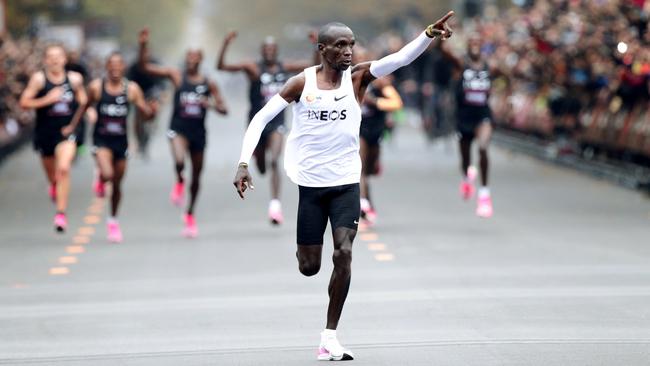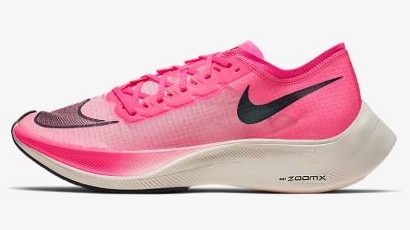Nike Vaporfly gives new meaning to going the distance
The Nike Vaporfly is revolutionising the choice of footwear among marathon runners but questions are being raised over whether it gives too much help.

The most controversial shoe in sports, the Nike Vaporfly, has become increasingly ubiquitous on the feet of elite athletes during several record-setting marathons in the four years since its debut.
Now, data suggests its lure is trickling down fast to everyday marathoners, who may actually stand to gain more from wearing the shoes.
The Vaporfly is a testament to technological innovation or a form of mechanical doping, depending on whom you ask. The superlight shoe, with an innovative midsole designed to generate extra spring, has quickly become the darling of elite marathoners intent on smashing records.
When Geoffrey Kamworor set a new men’s half marathon world record of 58 minutes and one second in Copenhagen in September, he did it in Vaporflys. Ditto for Brigid Kosgei, the Kenyan runner who smashed the 16-year-old women’s marathon world record last month in Chicago with a time of two hours, 14 minutes and four seconds. And, of course, Eliud Kipchoge just wore Vaporflys to become the first human to run a sub-two-hour marathon, albeit not in an official race.
Now the shoes are being adopted by recreational marathoners.
According to a sample analysis of about 15,000 Strava athletes who participated in the five Abbott World Marathon Majors this year — Tokyo, Boston, London, Berlin and Chicago — more than 1000 athletes laced up in Nike’s Zoom Vaporfly or most recent Next% models. At the TCS New York City Marathon last Sunday, the largest such race in the world, hundreds donned those shoes with hopes of running a personal record.
Similar to other elite racing shoes, the Vaporfly is impossibly lightweight. But unlike the shoes made by competing brands such as Adidas or Saucony, the Vaporfly’s midsole contains a thick layer of super squishy foam, which Nike calls ZoomX, and a carbon fibre plate. Biomechanics experts say the idea behind the carbon fibre plate is to mimic the spring amputee runners get from the blades of their prosthetics.

The spring allows athletes to exert less energy to run the same speed. The concept has been around for a little more than a decade, but Nike is the first manufacturer to successfully employ a carbon fibre plate in a shoe.
This marginal boost in efficiency may be hard to notice in a 100m dash, but Nike says it can improve a runner’s time by up to 4.2 per cent. In distances as long as the marathon, that’s significant — it would shave almost nine minutes off a 3hr 30min marathoner’s personal best. Several studies, by Nike scientists and independent teams at the University of Colorado and Grand Valley State University in Michigan, have found data that supports Nike’s 4.2 per cent claim.
According to South African sports physiology expert Ross Tucker, not all runners receive the same boost in running economy from wearing the Vaporfly. “The interesting thing is for the elite runners it translates to less than 1 per cent per per cent of economy, but for the back of the pack person they actually get more out of it.”
Per the Strava data, the runners who wore the latest Next% Vaporfly model posted the fastest median finishing time, 3hr 5min 35sec. Those Next%-clad runners ran at an average pace of seven minutes and five second per mile. Just behind that cohort of runners were athletes wearing Nike Zoom Vaporfly shoes, whose average pace per 1.6km was just four seconds slower.
There was a significant gap between runners wearing Nike’s two Vaporfly shoe models and those wearing the third best performing shoe, the Adidas Boston Boost. Runners in the top Adidas model ran at an average pace of seven minutes and 42 seconds per 1.6km and crossed the finish line more than 16 minutes behind runners in Nike Vaporfly shoes on average.
Runners wearing Saucony’s top performing shoe, the Kinvara, finished even further behind. At an average pace of 8min 1sec per 1.6km, Saucony-clad athletes finished about 24 minutes after their Vaporfly-wearing peers.
Within the Strava data there is some degree of selection bias, as it is likely that runners who logged their choice of footwear also happen to be some of Strava’s fastest daily users. Additionally, correlation between shoe model and median marathon pace does not explicitly prove that wearing Nike Vaporfly shoes will result in a faster marathon time.
But the advancing adoption of Vaporfly at the recreational level of running means debate over the shoe’s controversial construction is reaching a new strata of runner.
“Running is the sport where PBs (personal bests) and times and records and age groups and things, these things have meaning,” says Tucker. “I think that these shoes distort the meaning.”
The International Association of Athletics Federations, the governing body of running pursuits, has been aware of the controversy surrounding the Vaporfly since 2017.
In April the IAAF technical committee formed a working group of “two former athletes alongside experts in science, ethics, footwear, biomechanics and law” to determine whether a technical rule change was necessary to ensure that races be fair.
“The challenge for the IAAF is to find the right balance in the technical rules between encouraging the development and use of new technologies in athletics and the preservation of the fundamental characteristics of the sport: accessibility, universality and fairness,” an IAAF spokesman wrote in an email. The working group’s findings are expected this year, after each of the six major marathons this year is completed.
The Wall Street Journal


